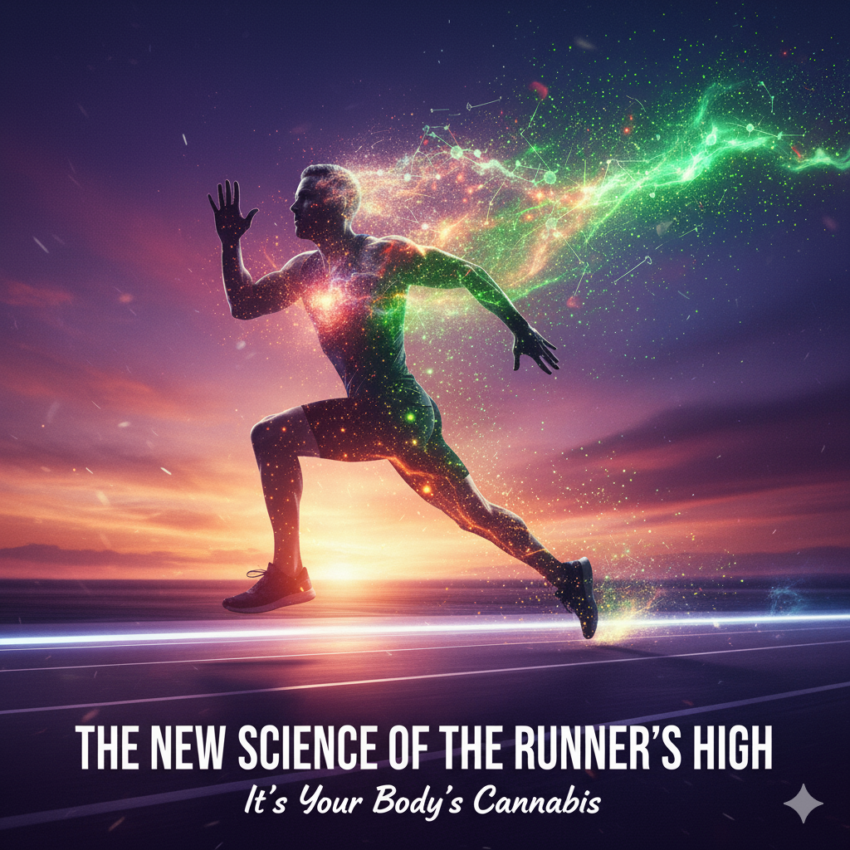The New Science of the “Runner’s High”: It’s Your Body’s Cannabis
For decades, the euphoric feeling experienced by many after sustained aerobic exercise—colloquially known as the “runner’s high”—was primarily attributed to the release of endorphins. However, recent scientific studies have largely shifted attention to another class of molecules: endocannabinoids. This system is the body’s natural version of the chemicals found in cannabis, and its activation is now considered the likely primary driver of the psychoactive benefits of cardio.
The Endocannabinoid System Takes the Lead ????
The long-held theory that endorphins were solely responsible for the runner’s high has been challenged on a fundamental biological level:
- The Blood-Brain Barrier Issue: Endorphins, which are large, water-soluble peptide molecules, cannot easily cross the blood-brain barrier—a protective membrane that separates the circulating blood from the brain’s fluid environment. This makes it difficult for peripheral endorphins to directly influence the brain areas associated with pleasure and euphoria.
- The Endocannabinoid Advantage: Endocannabinoids (eCBs), such as anandamide (often called the “bliss molecule”), are small, fat-soluble molecules. Their structure allows them to readily cross the blood-brain barrier and bind to cannabinoid receptors (like CB1) in the brain’s reward and mood-regulating centers.
- Research Findings: Studies in both mice and humans have provided compelling evidence.
- Animal models have shown that blocking endocannabinoid receptors eliminates the exercise-induced reduction in anxiety and pain, while blocking opioid (endorphin) receptors does not affect the euphoric aspects of the high.
- Human studies have shown that moderate-intensity running elevates plasma levels of eCBs, and some research indicates that the mood lift (euphoria and reduced anxiety) persists even when opioid receptors are pharmacologically blocked (e.g., with naltrexone), supporting the central role of the endocannabinoid system.
In short, while endorphins certainly contribute to pain reduction in the body during exercise, it is the easily brain-accessible endocannabinoids that are now considered the most likely cause of the subjective euphoric, anxiolytic (anxiety-reducing), and analgesic (pain-dulling) effects known as the runner’s high.
The Optimal Intensity for an Endocannabinoid Boost
Research suggests that the release of endocannabinoids is dependent on the intensity and duration of the exercise, and that there is a “sweet spot” for maximizing the effect.
- Target Intensity: Several studies have indicated that a moderate-to-high intensity level is required. Specifically, some research focusing on circulating endocannabinoid levels in runners found significant increases after exercising at an intensity of approximately 70% of maximum heart rate (HRmax) or in the range of 70–80% of Age-Adjusted Maximum Heart Rate (AAMHR).
- Intensity Comparison: Running at a moderate intensity (e.g., $\approx 70\% \text{ HRmax}$) appears to be more effective at generating an eCB boost than both very low-intensity exercise (like walking) or overly high-intensity efforts. The ideal seems to be sustained aerobic work for at least 30-45 minutes.
In practical terms, aiming for a pace where you can talk but not comfortably sing (often categorized as “vigorous” or “tempo” effort) for a sustained period is likely to be the best way to activate your body’s natural cannabinoid system and chase that euphoric runner’s high.
Cite Research:
- Fuss et al. (2015). A runner’s high depends on cannabinoid receptors in mice. Proceedings of the National Academy of Sciences (PNAS). (Key study linking cannabinoid receptors to anxiolysis and analgesia after running in mice, disproving the sole role of endorphins).
- Siebers et al. (2021). Exercise-Induced Euphoria and Anxiolysis Do Not Depend on Endogenous Opioids in Humans. Psychoneuroendocrinology. (Human study showing euphoria and reduced anxiety persist when opioid signaling is blocked, strengthening the endocannabinoid hypothesis).
- Sparling et al. (2003) / Sparling, T. P., Giuffrida, A., Piomelli, D., Dietrich, A., & Stoned, S. (2003). Exercise activates the endocannabinoid system. NeuroReport. (Early work demonstrating increased anandamide levels after moderate-intensity running/cycling, often cited in discussions of the optimal intensity).
- Dietrich & McDaniel (2004). Endocannabinoids and exercise: an update. British Journal of Sports Medicine. (Review discussing the inability of endorphins to cross the blood-brain barrier and the potential role of endocannabinoids in exercise rewards).
